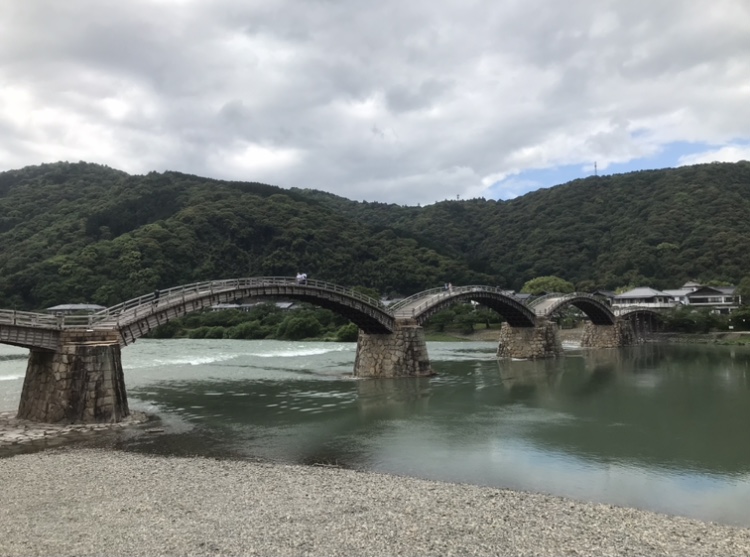
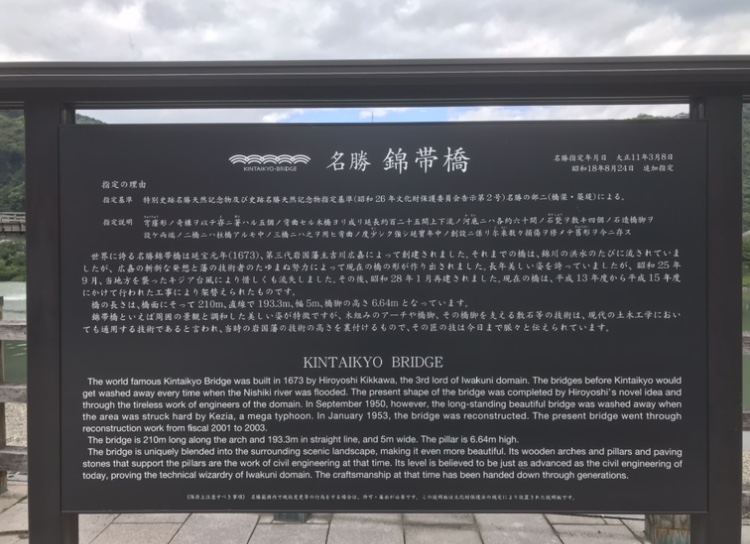
本日は、山口県岩国市にある『錦帯橋』についてご紹介させていただきます。
錦帯橋は1673年(延宝元年)に、岩国3代藩主吉川広嘉(きっかわ ひろよし)によって建造されました。
錦帯橋は、日本三名橋や日本三大奇橋でもあり、あまりのその美しさに見るもの全てが魅了されます。
なぜ、このような形になったのか、その要因となったのが度重なる洪水が原因でした。
Today, I would like to introduce “Kintai Bridge” in Iwakuni City, Yamaguchi Prefecture.
Kintaikyo Bridge was built in 1673 (the first year of Enpo) by Hiroyoshi Yoshikawa, the third feudal lord of Iwakuni.
Kintaikyo Bridge is also one of Japan’s Three Famous Bridges and Japan’s Three Great Strange Bridges, and its beauty is fascinating.
The reason for this shape was the repeated floods.
暴れ川「錦川」 対策のために架けられた5連続アーチ橋
Five consecutive arch bridges built for countermeasures against the rampage river “Nishiki River”
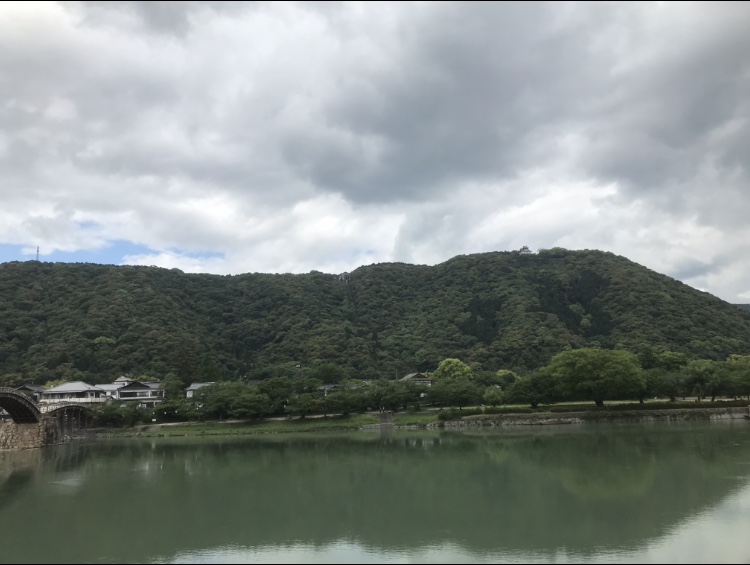
初代岩国藩主は、関ヶ原の戦いで徳川家康の口車に乗せられ、まんまと罠に嵌められた「吉川広家」です。彼は、毛利家減封の立役者となった不名誉な人物と言っても過言ではないでしょう。
しかし彼のおかげもあり、臥薪嘗胆の結果、幕府をも超える最強・長州藩が誕生しました。
彼の時代から、岩国城が建築されましたが、錦川と対岸にある城下町を掛ける橋が錦川の洪水により、度々流出していました。
日本には、坂東太郎「利根川」・筑後二郎「筑後川」・四国三郎「吉野川」と、日本三大暴れ川がありますが、この錦川も引けを取らないほど、暴れ川として江戸時代は有名でした。
この暴れ川問題に終止符を打ったのが、3代藩主の「吉川広嘉」です。
橋脚をなくせば流失を避けられるとのアイデアのもと、大工の児玉九郎右衛門を甲州に派遣し、橋脚がない跳ね橋(刎橋)である猿橋の調査を命じた。
しかし、川幅30メートルの所に架けられている猿橋に対し、錦川の川幅は200メートルもあるため、同様の刎橋(はねばし)とするのは困難であった。
広嘉がある日、かき餅を焼いていたところ、弓なりに反ったかき餅を見て橋の形のヒントを得たという[5]。また、明の帰化僧である独立性易から、杭州の西湖には島づたいに架けられた6連のアーチ橋があることを知り、これをもとに、連続したアーチ橋という基本構想に至ったともいわれている[6]。アーチ間の橋台を石垣で強固にすることで、洪水に耐えられるというのである。延宝元年(1673年)6月8日に基礎の鍬入れが始められ、児玉九郎右衛門の設計により、石で積み上げられた橋脚を川の堤防に2個、中間に4個の計6個築き、その上から片持ちの梁をせり出した木造の5連橋を架けた[7]。広嘉は近くに住居を構えて自ら架橋工事の監督を行い、扇子を開いてアーチ橋の湾曲の形を決定したという[6]。同年10月、錦帯橋は完成し、地元で家内睦まじいことで評判の農家清兵衛の一家12人による渡り初めが行われた[6]。
出典: フリー百科事典『ウィキペディア(Wikipedia)』錦帯橋 より
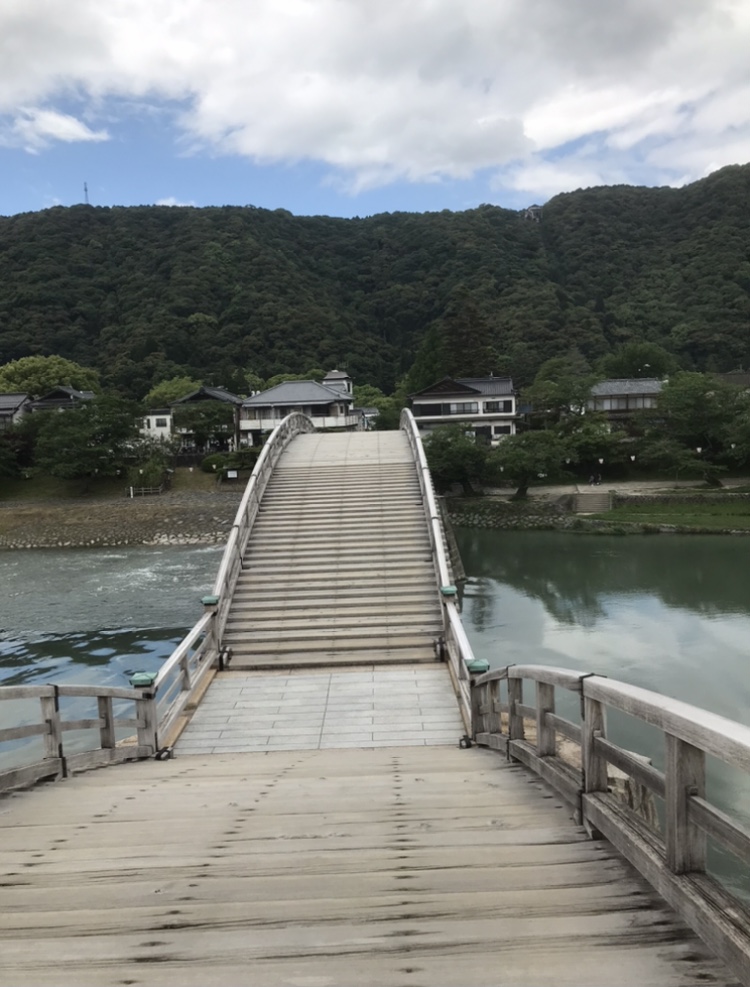
このように、錦帯橋は完成されたとのことですが、同じ日本三大奇橋である「猿橋」を参考にして作られたということには驚きました。
どちらかといえば、錦帯橋の方が日本を代表する建築物のイメージが強かったため、猿橋の方が古い歴史にはびっくりです。
また、他県(当時は他国)へ偵察するのも、藩の財政を良くするために、他を参考にする(=新たな良いものを取り入れる)姿勢は素晴らしいと思います。酒池肉林に陥り、驕り高ぶる藩主が多い中で、このように藩を第一に考える姿勢は参考にするべきと考えます。
次章では、錦帯橋の魅力について、ご紹介させていただきます。
The first Iwakuni feudal lord was “Kikkawa Hiroie” who was put on the mouth of Ieyasu Tokugawa at the Battle of Sekigahara and was put into a trap. It is no exaggeration to say that he was a disgraceful person who was the driving force behind the Mori clan.
However, thanks to him, as a result of the courage to lie down, the strongest Choshu clan, which surpasses the shogunate, was born.
Iwakuni Castle was built from his time, but the bridge between Nishiki River and the castle town on the opposite bank was often leaked due to the flood of Nishiki River.
In Japan, there are Bando Taro “Tone River”, Chikugo Jiro “Chikugo River”, Shikoku Saburo “Yoshino River”, and Japan’s three major rampage rivers, but this Nishiki River is also famous as a rampage river in the Edo period. did.
Kikkawa Hiroyoshi, the third feudal lord, put an end to this rampage problem.
Based on the idea that the loss of piers could be avoided, a carpenter, Kuroemon Kodama, was dispatched to Koshu and ordered to investigate Saruhashi, a drawbridge without piers.
However, compared to Saruhashi, which is 30 meters wide, the width of the Nishiki River is 200 meters, so it was difficult to make a similar drawbridge.
One day, Hiroyoshi was baking okaki rice cakes, and when he saw the shavings that warped in a bow, he got a hint of the shape of the bridge. [5] Also, from Obaku Dokuryu, a monk of Ming, he learned that there are six arch bridges over the island in Xihu, Hangzhou, and based on this, he came up with the basic concept of a continuous arch bridge. It is also said to be [6]. By strengthening the abutment between the arches with stone walls, it can withstand floods.
The foundation piercing began on June 8, 1673, and the stone-stacked piers were designed by Kodama Kuroemon, with two piers on the river embankment and four in the middle, for a total of six. It was built, and a five-storied wooden bridge with cantilevered beams was erected from above. [7] It is said that Hiroyoshi set up a house nearby and supervised the bridge construction himself, opened the fan and decided the shape of the curve of the arch bridge. [6] In October of the same year, the Kintaikyo Bridge was completed, and the beginning of the migration was carried out by 12 members of the Seibei family, a farmer who is reputed to be a local farmer. [6]
In this way, it is said that Kintaikyo Bridge was completed, but I was surprised that it was made with reference to “Saruhashi”, which is the same three major strange bridges in Japan.
If anything, Kintaikyo Bridge had a stronger image of a building that represents Japan, so Saruhashi is more surprising in its old history.
Also, I think it is wonderful to scout to other prefectures (at that time, other countries) by referring to others (= incorporating new good things) in order to improve the clan’s finances. While there are many feudal lords who have fallen into the sake pond meat forest and are arrogant, I think that this attitude of putting the feudal lord first should be used as a reference.
In the next chapter, I will introduce the charm of Kintaikyo Bridge.

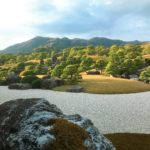

コメント